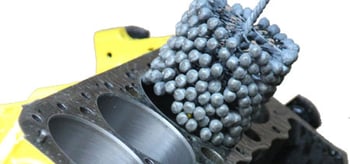
Engine cylinders need a substantially smooth surface finish that’s free from cut, torn, and folded metal. Yet cylinder walls can be so smooth that engine performance suffers.
Over time, the up-and-down movement of pistons creates an overly smooth surface finish. Piston rings skate along cylinder walls and fail to seat and seal properly. The “glaze” that forms can also prevent engine oil from adhering properly.
The solution to these challenges is the Flex-Hone® tool from Brush Research Manufacturing (BRM). This Made in the USA glaze-breaker hone removes burrs, deglazes cylinder walls, and improves surface finish at the same time. That’s why bloggers like The Bug Boys use BRM Flex-Hone® tools for engine rebuilds.
Ball Hones for cylinder surface finishing
In a post called Honing a Saturn’s Cylinder Wall, a blogger from The Bug Boys wrote that “I used a ball hone and it worked great”. The BRM Flex-Hone® broke the glaze that had formed on the Saturn engine’s cylinder walls and imparted a uniform series of grooves for optimum lubrication. This plateau finish with its substantially-smooth peaks and oil-retaining valleys also supports piston ring seating and sealing.
Mechanics who call flexible hones “ball hones” or “dingleberry hones” do so because the Flex-Hone® tool has abrasive globules that are permanently laminated to flexible nylon filaments. This unique construction supports the tool’s soft abrading action and makes the ball hone or dingleberry hone self-centering, self-aligning to the bore, and self-centering for wear.
How to Use a Glaze Breaker Hone
As shown on The Bug Boys website, the Flex-Hone® mounts in a handheld electric drill. We’re not sure which size tool The Bug Boys used, but the diameter was probably between 1/2” and 2” since the blogger reported good results at 1000 RPM. As the Flex-Hone® Resource Guide explains, revolutions per minute (RPM) vary with the tool diameter and surface finishing requirements.
Flex-Hone® tools also require the use of a good-quality honing oil and should be inserted into the bore while the cylinder hone is spinning. For best results, start slowly, increase the RPMs, and exit the bore with the tool spinning. The blogger from The Bug Boys took this approach and reported “better cross hatch marks and a cleaner cylinder,” adding that “your cross hatch marks should be about 45 degrees.”
Next, the engine mechanic cleaned the freshly-honed cylinders using hot soapy water and a cylinder wash brush. After wiping down the walls, he applied a thin coat of motor oil. The blogger then made plans to reassemble the engine and get his Saturn back on the road.
Get the Automotive Engine Rebuilder Case Study
Would you like to learn more about how engine rebuilders use Flex-Hone® tools? Then download the Automotive Engine Rebuilder case study and learn how RMP, a New Jersey remanufacturer of car and truck engines, got great results.









